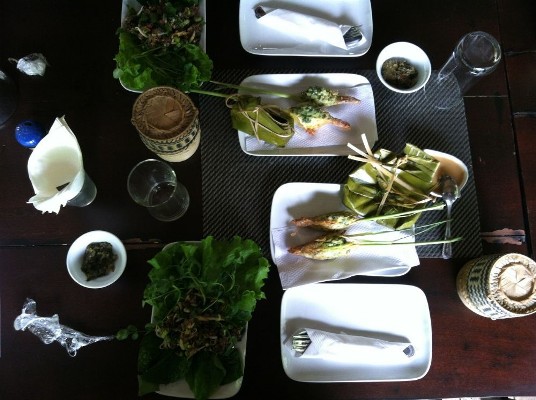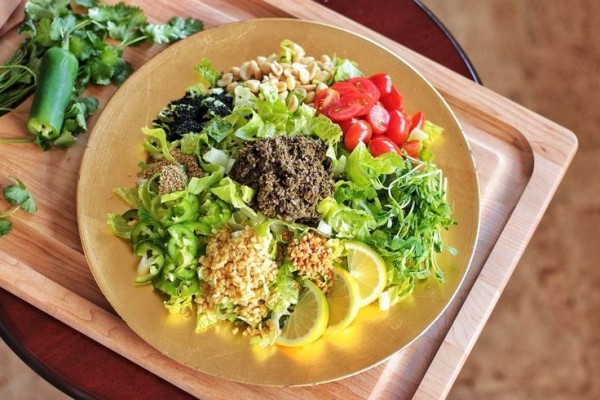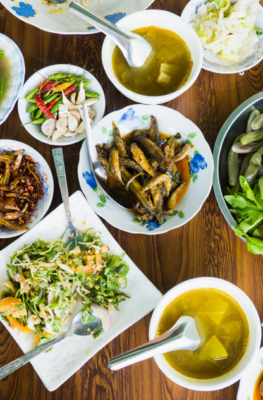Published on April 13, 2015
Within the context of a continuing search for South East Asian dishes that are a bit more out of the ordinary, lesser known and not everywhere available, in a previous article a dying out fish preparation (“Ikan Masak Tanah Liat), a rare breed of crab (“Talangka”) and a protein rich meal (“Cha Ruoi”), respectively from Malaysia, The Philippines and Vietnam, were highlighted.
The prevailing article again likes to whet your appetite with similar, somehow extraordinary dishes when visiting Brunei, Laos and Myanmar during your holidays.
Starting with Brunei Darussalam which cuisine shows many similarities with its neighbours, Malaysia, Singapore and Indonesia, an authentic delight worthwhile to keep your eyes open for is “Tongkeng Ayam”, less commonly served nowadays. However, a good chance of enjoying a good helping of it is by paying an indispensable visit to Brunei’s night markets in Gadong, where a variety of authentic food both, filling and affordable, is displayed for locals and tourists alike.
Of course you can try traditional dishes like satay, Hati Buya (stir fried sliced beef lung) or Pulut Panggang (grilled banana leaves filled with sticky rice, prawns or beef). But how about a more daring, generous portion of…cute chicken butts, also known as Tongkeng Ayam! A treat highly recommended by connoisseurs.

If eating chicken butts can’t be considered exotic, may be just a reason to poke some fun, the next food regards more serious matter, notably intestines. Laotians, not only eat the meat of animals – it’s actually viewed the least preferred part by them – they digest everything, blood, intestines, acids, you name it. The historical reason given is that if you don’t have an abundance of obtainable food, you will use whatsoever is for grabs in the area. Thus, Laotians are fully compelled to eating the animal entirely. The intestines are considered the best part, followed by foot, bone and tendon; meat turns up last. So, don’t be surprised to see buffalo intestine, raw duck-blood soup or iguana on the menu, here and there.
Having travelled around a bit, I no longer raise an eyebrow when presented with raw sheep’s eye, uncooked snails or goat testicles for starters, but admit that reading about Laotians habitually cooking with watered down animal bile, did upset my stomach an inch or two. The substance is called “Pia” (“or Ki Aun”), roughly translated into English as “soft poo” by the locals. Bile is a digestive fluid, stored in the gall bladder that helps the body break down fats.
So, if you are in for a real adventurous experience and happen to travel around the remote North of Laos, you won’t miss it since Pia is in almost all of the food that is consumed. Moreover, you can learn more about it when taking cooking classes on Laotian food preparation in Luang Prabang. To be honest, it’s actually not as bad as it looks like and the food quite edible, according to the following blog: http://munchies.vice.com/articles/i-cooked-with-soft-poo-in-laos

To round it off on a more refined note, a dish from Myanmar, a rapidly emerging tourism destination that received just over 3 million foreign tourists in 2014, more than 50% compared to 2013. Myanmar is one of a handful of countries where tea leaves not only are used for drinking, but for eating as well. In this case in the form of a ‘Myanmar salad’, called “Laphet Touq” (pronounced La Pet Thoke).
Myanmar salads are a heavy and filling affair, a dense mixture of thinly sliced vegetables, nuts, sesame oil, sauces, and occasionally meat or seafood. What sets the tea leaf salad apart from the rest is that its main ingredient is soft and greasy fermented tea leaves; in addition it consists of a ready-made mix (sold in huge sacks at the local markets) of fried beans, peas, and garlic, toasted sesame seeds, crispy chickpeas, sunflower seeds and roasted peanuts. Dried shrimp can be added too, for extra crunch (as if that is needed), as well as thinly sliced tomato and chilli. A generous slug of oil is added and the whole lot is mixed by hand.
It has an incredible balance of soft and crunchy, sweet and savoury, but the caffeine in the pickled tea leaves meant for some a few sleepless hours. Be forewarned!

Brunei, Laos and Myanmar
Culinary expeditions to some lesser known parts of South East Asia






